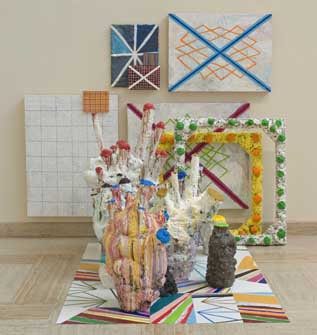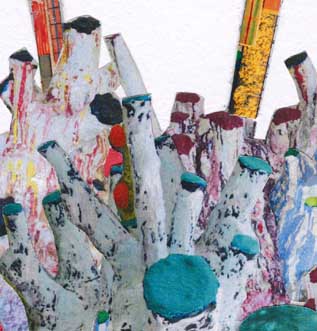
|
||
|
Portland art blog + news + exhibition reviews + galleries + contemporary northwest art
|
||
Jesse Hayward at the Oregon Biennial 
Jesse Hayward's Large Pod Project at the Oregon Biennial Mutant, bulbous, fungal protuberant objects cluster together in a corner of the outer gallery at the PAM Biennial. Hayward's work is messy and accumulative, and carries the same dense and subtle visceral menace as refrigerator mold. Hayward's clusters complicate and problematize the inertia of "the art object." Hayward suggests the possibility of mutation, of capacity for growth and self-change as a latent property of the object itself, rather than a function of the artist. The objects seem independent of the artist, they seem to will their own growth, they proliferate as easily, inexorably and as repetitiously as daisies in a field. And there is a strange uneasiness with this kind of work, the familiar anxiety of the mess, or the cluster. The clean, bright surfaces of the PAM have fallen prey to the weirdness of Hayward's organism.  a detail of Hayward's digital proposal The sculptures have no sense of their end-point, no conclusive finish. They seem, weirdly, to be still growing. Although Hayward engages the basic tropes of art-making, what finally emerges is something alien. The objects exist in a state of diminished hybridization, with multiple genres parasitically collapsing one another. Sculptural traits wrench stretchers from the wall, burning out the canvas. Empty stretchers are stacked together as if stored, color and texture accrete to the point of obscuring and softening the original rigid structure. Color accretes so much that it takes on a sense of independent vitality. It seems mobile, gooey, infectively burgeoning. Hayward dissimulates art as the product of work or craft. The impetus of the painting/ sculpture/ installation hybrid seems an internal quality of the object itself. Rather than seem a product "completed" by the artist, the objects seem totally self generative, the natural fungal decay of art materials left too long in a dark damp store-room. The objects give the feeling of neglect or abandon, highlighted by the empty stretcher frames stacked together: the by products of unfinished studio labor. The frames accrete color without the presence of the surface: Hayward skips a step, short-circuiting the "correct" studio process and moving immediately from stretcher to paint. The paint provides its own surface, adhering to everything parasitically, like barnacles. The color has its own will, finally freed from the sublimation of the complex goals of painting: communication, illusionism, expression. Instead the color grows according to a biologically programmed will, according to the evolutionary principle: "It doesn't need to be perfect, reasonable or mean anything, it just needs to be able to indefinitely reproduce." Despite the immediate repulsion of this inexorable, non-rational, biological will, the color itself is exuberant, riotous, ecstatic. Life cannot be stopped, and is not answerable to the functional or ethical constructions of human society: rationalism, pragmatism, morality, beauty. Kant defines beauty as: The functionless which seems to have a function. To Kant, the ultimate justification for making art is that it serves some function to society, i.e. beauty enriches our lives. But nature has no such responsibility to the functional enrichment of human society. Beauty in nature only coincidentally fulfills enlightenment ideals. The goal of nature is not to apply function to the irrational, but rather to irrationally, constantly, mindlessly reproduce. The imposition of human aesthetic constructions on this principle is only arbitrary. The proliferation of daisies delights us while the proliferation of cheese mold disgusts us. Hayward's aesthetic falls somewhere in between the delight of a field of daisies and the revulsion of cheese mold. As in natural proliferations, Hayward favors repetition. The cluster of panels in the installation all bear the same pattern: a simple bisection of the rectangular panel, mostly diagonally, sometimes vertically and horizontally, forming a repeating pattern of "X" and star. These central patterns often occur over a grid, the most elemental description of a 2-D rectangular surface. Often, loose traceries of diagonal line-work intersect the "X" pattern alternately creating a spider-web or argyle pattern. Weaving (web making) being another activity guided by principles of biological growth. The cluster of X and Star panels seem as exuberant and effervescent as a field of daisies, having the quality of a cloud of little bright bursts. However, a bisecting X across the center of a panel is essentially a nullification. Hayward dismantles the romance and communicative properties of the picture plane by geometrically dismantling it. The simple "X" , Star, and Grid, reveal the picture plane as a coordinate system, marking the corners, the center, the midpoint of each side, and the X-Y integer positions. The image is only an assertion of the structure. As in nature, structure proliferates repetitiously, without meaning. As in any growth pattern, Hayward's panels reveal their components and the points of their generation (center, mid-points, grid co-ordinates). Where Kant would see geometric progression as a manifestation of Enlightenment ideals (inherent rational pattern in nature), nature sees geometric progression as an effective means to an irrational end: interminable self-copying. But irrationality is the source factor of that most elusive of states: the ecstatic. If the goal of Enlightenment philosophy is the rational pursuit of increasing human happiness, the inner conflict of this philosophy must be noted. Ultimately, happiness is an irrational state. If ecstasy is to be experienced we must risk the loss of rationality, we must dare the idea that the functionless may indeed be only that. Art and emotion may indeed be pointless, may indeed be only ephemeral sensations. In dismantling the picture plane into self-evident coordinates, dissolving the canvas off the stretchers, and confusing and accreting the tropes of painting, drawing, and sculpture, Hayward gains this rare access to the irrational and ecstatic. Posted by Isaac Peterson on September 04, 2006 at 1:19 | Comments (2) Comments Ike, eventhough I know Jesse and his work pretty well this avalanche of words really helped me put the biennial piece into perspective. It isn't one of my favorite works by him (it needed to be 3 times this size) but I do like how uneasy and unstable it is. I like the effect of purposefully "unrealized" potential on the show. If art is a chess match, it's a great opening move. In most ways it is the only thing at the biennial that seems to destabilize a very stable, well behaved show (yet the scene itself is constantly mutating). Originally, I thought you were going to write about another artist?... but it makes sense to pick this since Hayward's work is the most contentious thing at the biennial. (my 2 cents) The best piece is Vanessa Renwick's video. I might hold onto my big biennial review till later this month so the show can continue to be explored and discussed. Also, Hayward's show at Chambers should really throw people for a loop as well, its much more resolved. Wheeler's photos are pretty amazing and it's an inspired combo. Healy's show though will be the biggest event this September (even if it stinks people will want to dicuss why it stinks). Years ago, Sean upon seeng Hayward's work at Haze noted how he had to step it up. Healy has, but at this point it's more than just the work itself, it's how well the entire hang works together as a show. Im anxious to see Clenaghen at PullDeff, Tyler Kline at Zeitgeist and Schmeltz at Tilt too. Its a great September and Healy has the first highly anticipated multimedia solo show since Ehlis' clinic last year in multi-series viruosity. (Clenaghen, Healy and Ehlis have a certain rivalry that keeps them all sharp and edgy, for a while they always had shows at the same time). Clenaghen, Healy and Ehlis were the breakout artists of the 1999 biennial and they have matured into very accomplished A-listers who make work that stands out, even compared to LA's best young artists etc. This year it looks like Hayward and maybe Houston (his work has good initial effect but not much upon second viewing) are the two breakouts this time around. There wont be any immediate answers, it will play out in a couple of years. Ive seen Hayward's Chambers show though and he surprised me how good it is (before this he has been a good artist whose work varies from great to rehashed). He's come a long way since Haze. The museum is free today, so check it out. Posted by: Double J There is something quite delightful about seeing Hayward's purposely messy and neglected piece within the walls of PAM. I need to visit the Biennial another time to further inspect the organism that is Hayward's work (and all the other works as well). Fantastic line by the way Isaac: "Hayward's aesthetic falls somewhere in between the delight of a field of daisies and the revulsion of cheese mold." So true. Posted by: Calvin Carl Post a comment Thanks for signing in, . Now you can comment. (sign out)
(If you haven't left a comment here before, you may need to be approved by
the site owner before your comment will appear. Until then, it won't appear
on the entry. Thanks for waiting.)
|
| s p o n s o r s |
 |
 |
 |
 |
 |
 |
 |
 |
 |
 |
 |
 |
 |
 |
 |
 |
 |
 |

|
Site Design: Jennifer Armbrust | • | Site Development: Philippe Blanc & Katherine Bovee | |


![[TypeKey Profile Page]](http://www.portlandart.net/nav-commenters.gif)